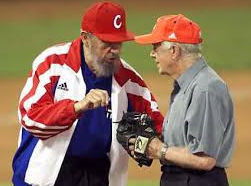 President Barack Obama made history on his arrival in Havana on Sunday. “The first U.S. president to visit Cuba since Calvin Coolidge visited in 1928,” said all the news stories.
President Barack Obama made history on his arrival in Havana on Sunday. “The first U.S. president to visit Cuba since Calvin Coolidge visited in 1928,” said all the news stories.
Yes, Obama is the first sitting president to land on Cuban soil since Coolidge. But let’s not forget Jimmy Carter’s equally momentous trip to the island nation in 2002.
Carter went as a private citizen, of course. But he made great strides in opening the door to better relations between the world’s superpower and one of the world’s few remaining communist countries. That visit contributed to making Obama’s olive branch possible.
Carter met with Cuban leaders as well as political dissidents. He went to a baseball game with Fidel and delivered a speech broadcast on Cuban national television. Obama’s agenda is very similar.
I was lucky enough to go to Cuba to cover Carter’s journey to Cuba for Cox Newspapers. It’s hard to believe that was 14 years ago. It’s also hard to find the stories I wrote online. So here is a snippet of one of the first ones that published after reporter Mike Williams, photographer David Tulis and I had melted waiting on a hot Havana tarmac for the former president and his wife, Rosalynn, to land. It’s excerpted from the wire story sent out by Cox:
It was a day of rarities in Havana.
The Star Spangled Banner, heard only at a few sporting events, roared through a loudspeaker. Old Glory fluttered in the balmy breeze. And the historic Cuban capital opened its doors for an equally historic visit.
With the landing of his private jet on Sunday morning, Jimmy Carter became the first former or serving United States president to touch Cuban soil since the 1959 revolution that hurled Fidel Castro to power.
The 75-year-old Cuban president shed his usual military fatigues for a dark, double-breasted suit and black leather sports shoes to personally welcome Mr Carter and a seven-member Carter Centre delegation to the Cuban capital.
Mr Carter, 77, who is in Cuba on what he emphasises is a private visit, flashed his signature smile and shook Dr Castro’s hand shortly after his jet, donated by an Atlanta businessman, touched down at 10.45am.
The mood was almost as warm as the weather as Mr Carter began an unprecedented six-day mission to overcome four decades of enmity between the US and the communist island.
Mr Carter said he was delighted to be back in Cuba, where he and his wife had holidayed shortly before the revolution.
Dr Castro expressed his respect for Mr Carter, and has ensured him free access to the country’s institutions and people.
A meeting is planned on Thursday between Mr Carter and Cuba’s religious and human rights leaders, who are seeking to reform the country’s authoritarian one-party system.
Mr Carter, a global peacemaker and champion of human rights, acknowledged disagreement with some of Dr Castro’s policies but said he looked forward to the opportunity to see Cuba at first hand. Dr Castro specifically invited Mr Carter, a nuclear physicist, to tour Cuba’s scientific development and research centres, which the US, just days ago, accused of making biological weapons.
The two men walked down a dusty red carpet laid out on the tarmac and onto a podium where the Cuban and US flags flew side by side. Mr Carter and his wife, Rosalynn, flanked Dr Castro at the podium and placed their right hands over their hearts during the Star Spangled Banner.
As night fell, Dr Castro met Mr Carter again for a state dinner at the Palace of the Revolution. He awaited his guests, who pulled up in a black Mercedes-Benz, at the top of three sets of marble stairs covered with red carpet. The pair were to dine again on Monday night.
Earlier in the afternoon the Carters emerged into the heat for a walking tour of Old Havana, a district rich in architecture and dotted with picturesque plazas.
Dressed in white Reeboks, white trousers and a white shirt that seemed a modern version of a guayabera, a traditional pleated men’s shirt popular in Cuba, Mr Carter strolled the streets hand in hand with Mrs Carter.
The Carters began their tour at the Cathedral of Havana, restored in the past decade and now a popular Sunday destination for Cuban Catholics. Cuban authorities suppressed organised religion for decades after the revolution, but since the Pope visited the island in 1996 religious activity has been allowed.
Along the route of the walking tour, Cuban families crowded iron-railed balconies to catch a glimpse of the former president, many drawing waves and smiles from the Carters.
